Visual Manifestations and Image-making by Viswanath Kuttum
Written by Juhi Mathur
The artistic journey of Viswanath Kuttum is expansive and experimental, drawing from anecdotes and observations throughout his childhood. The cultural impact is translated into various forms that denote deeper understanding of various customs from his community. Born in the Andamans, Kuttum’s childhood was spent on the island, surrounding the might of nature, its beauty – daunting and inviting.
.
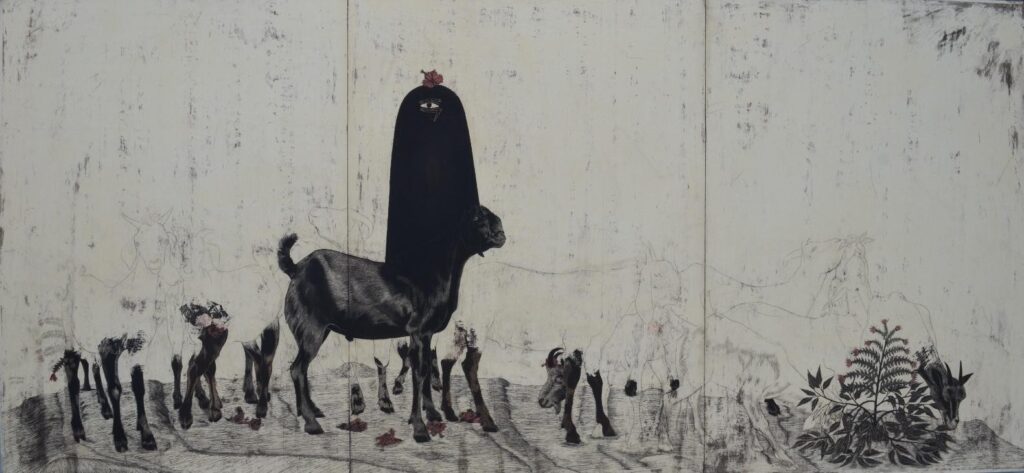
.
As renowned neurologist Sigmund Freud deciphers the depths of the unconscious mind, he looked at the medium of art as a process of wish fulfilment, and moreover a result of a complex combination of childhood memories and repressed desires. In 1910, Freud published an essay called Leonardo da Vinci, A Memory of His Childhood, – in which Freud analysed the life of famed artist Leonardo da Vinci, focusing on his memorieshis youth citing them as a main motivator behind his imagery and motifs, making the written record as the first data on the psychoanalytic interpretation of art. In a similar method of interpretation, Kuttum’s art practice is a result of observation and remembrance, he has taken his experiences from childhood, and transformed them into motifs which signify deeper cultural practices and norms.
Kuttum’s ancestry can be traced back to the lands of Telangana, in the village of Makkanpalli Makkapally), which is known for the farming of cashews which is also known as ‘white gold’ and his creative expression incorporates elements from the rituals practiced in his community. A few of them namely – goat, a cane basket, bamboo, and hibiscus. Kuttum retells the story of different celebrations that take place in his community, he focuses on the tradition of community. Each community is defined by their traditions and rituals and that becomes the crux of Kuttum’s creative expression. Located on the border between Odisha and Telangana, the festivals of the community are defined by different harvest seasons, and weddings, which were accompanied with various types of art forms like decorating the houses, and the main community spaces, this was Kuttum’s first experience with folk traditions of art. One of anecdotes involves the preparation of offerings for deities, specifically using a clay or a metal pot and filling it with jaggery, rice, pulses and covering it with a basket. This pot is then taken to the houses in the village by the male members of the society, accompanied by traditional dance, adding another of performativity to the ritual. This harvest season festival which is similar to the popular festival of Makara Sankranti and the presence of a cane basket which adds to the sacred nature of offerings has become an integral part of Kuttum’s paintings. Drawing from these rituals, a series of works by Kuttum focus upon the creation of a cane basket as each element is highlighted in the artwork as each aspect of the basket occupies the central position in his works. There is a rustic charm that underlines these compositions as he deciphers his own imagination that weaves the real world with the musings of the unconscious mind.
.
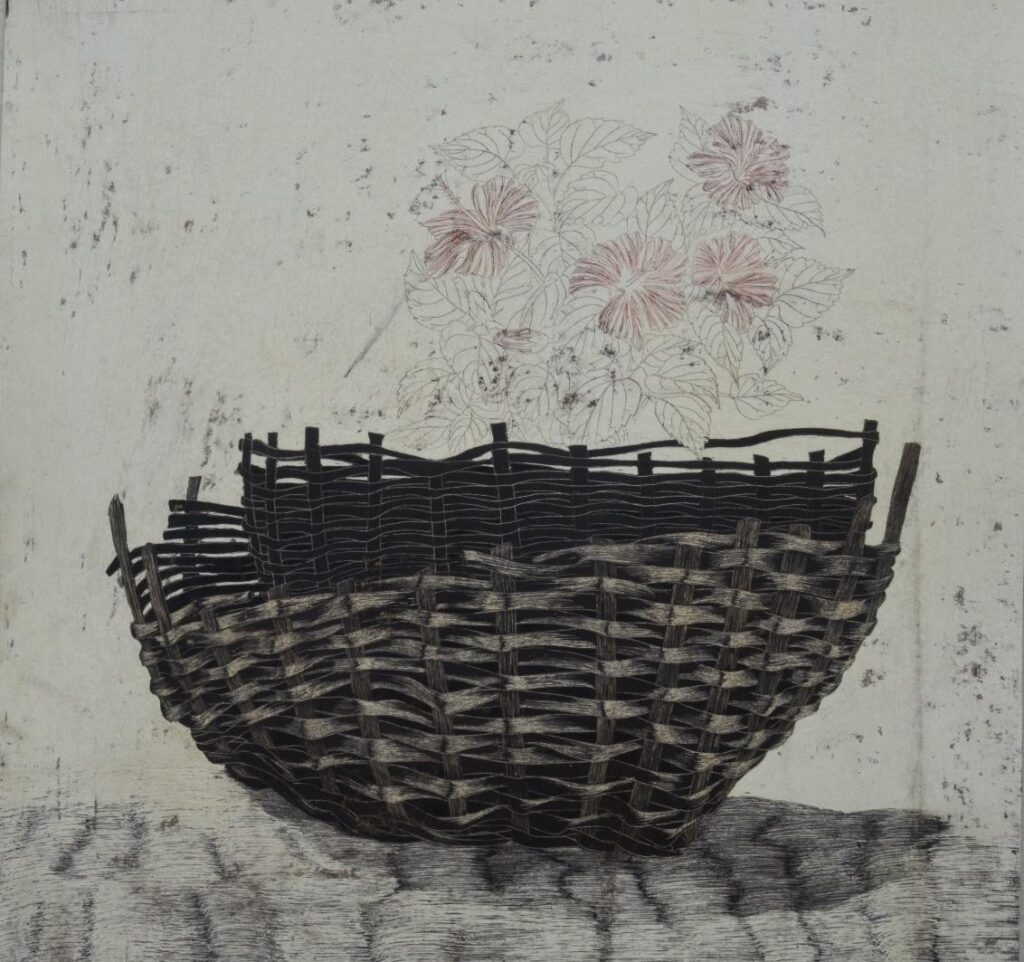
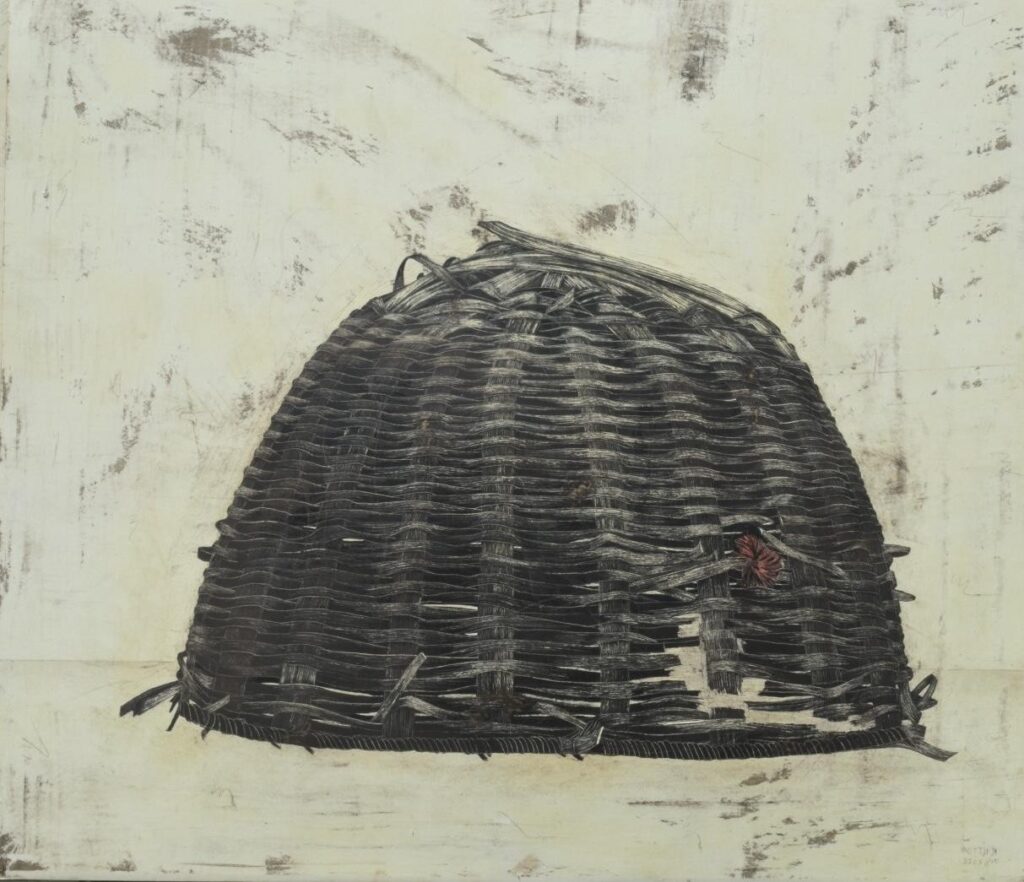
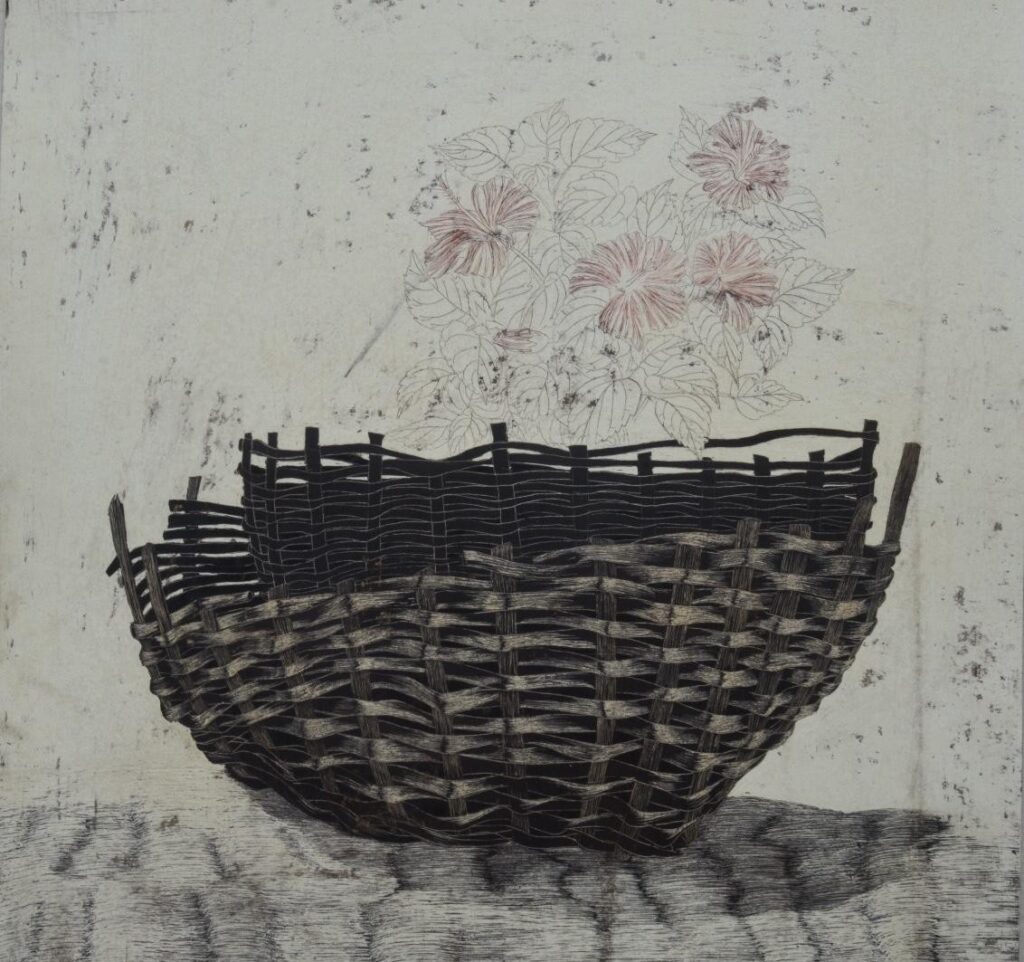
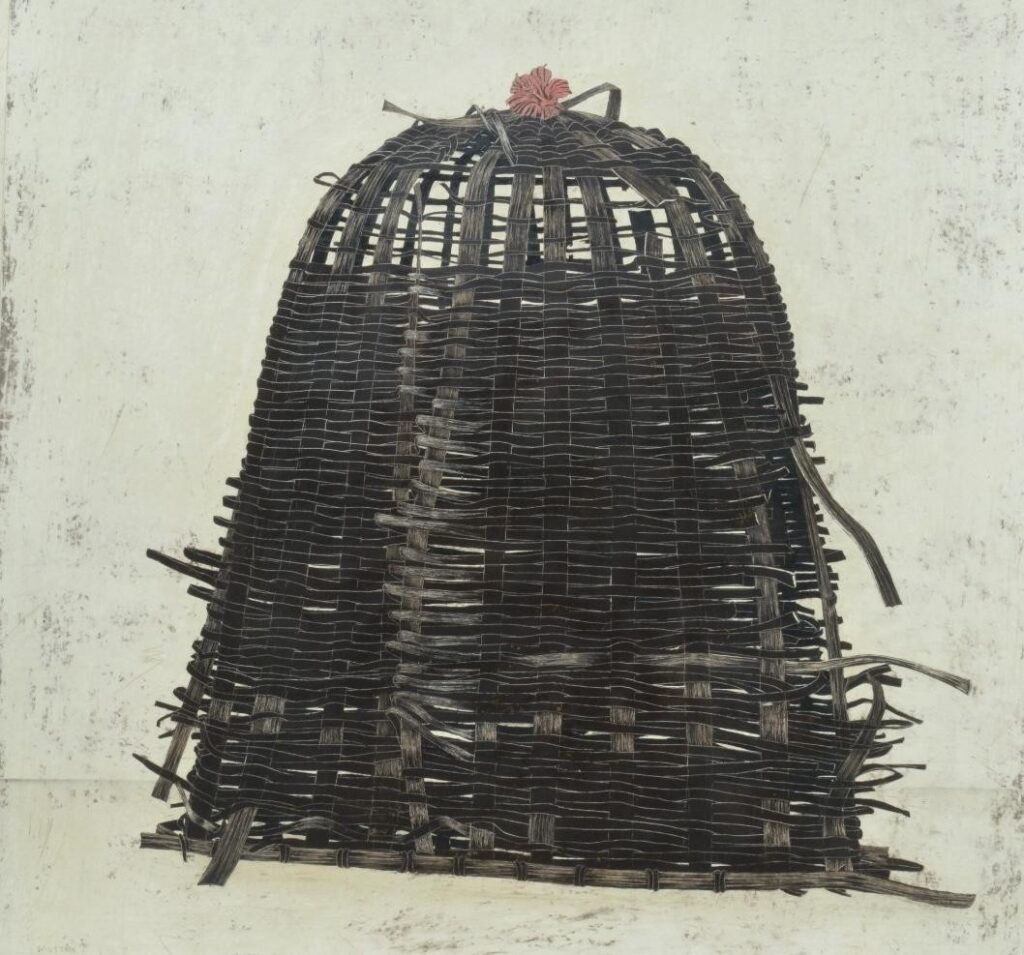
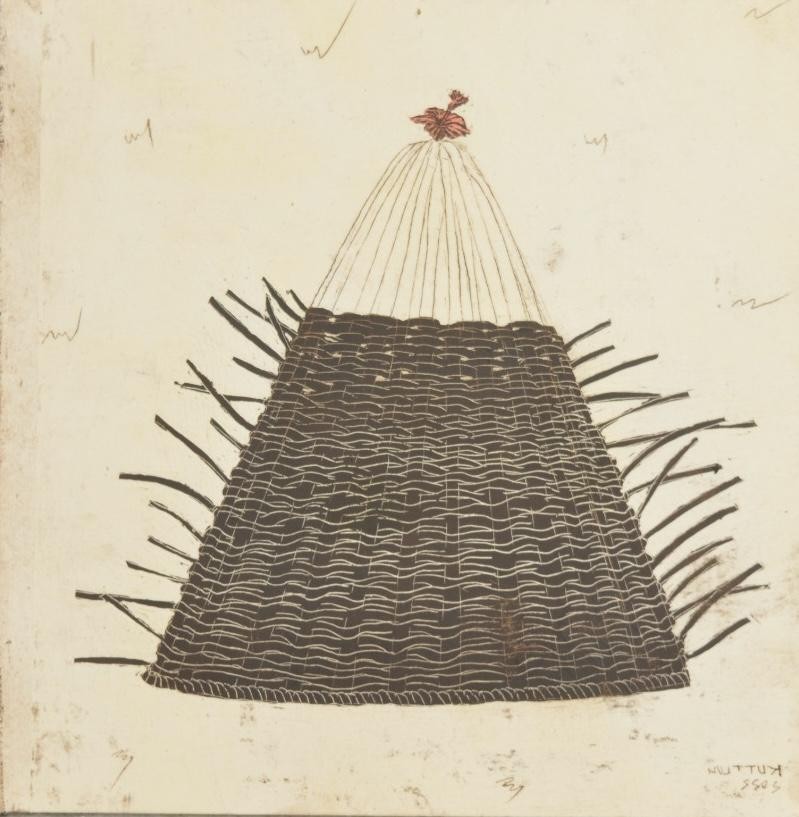
.
In each composition, Kuttum has focused on the materiality of the basket, focusing on its importance in a ritual, while delineating the faint shadows of hibiscus flowers which are used as offerings for the deity. In terms of the composition, the colour scheme is subtle and grounded in Kuttum’s experience of his surroundings, as he creates a dramatic contrast with an ochre-toned background that takes inspiration from the bucolic land of Andamans; sprawling lands and mountains surrounded by the ocean. Kuttum’s artistic expression takes inspiration from nature and the landscapes become entities in his artworks, illustrated in definitive schemata which shows restraint and tactful usage of space. He celebrates the might of nature and the untouched beauty of his hometown, while touching upon the various customs of his community whose rituals are also deeply connected to the worship of nature, specifically the lunar and solar deities. The tradition of carrying the basket-covered pot for worshipping is also followed by sacrificial practices, most prominently the sacrifice of a goat. This practice becomes codified in Kuttum’s visual vocabulary as well, as he incorporates the motif of a goat to harken back to ritualistic aspects of community and showcases the reverence for nature in multiple ways.
Incorporating his compositions with a sense of layered narratives, Kuttum’s art presents the complexities of human mind and memory. He looks at life, people, and their surroundings from multiple perspectives, breaking down each facet of human belief into a legitimate motif. He focuses on mythologies which bring people of a community together during the times of celebration as well as sorrow, where artistic expression is an act of worship, and part of a larger cultural history of that place and its people.
.
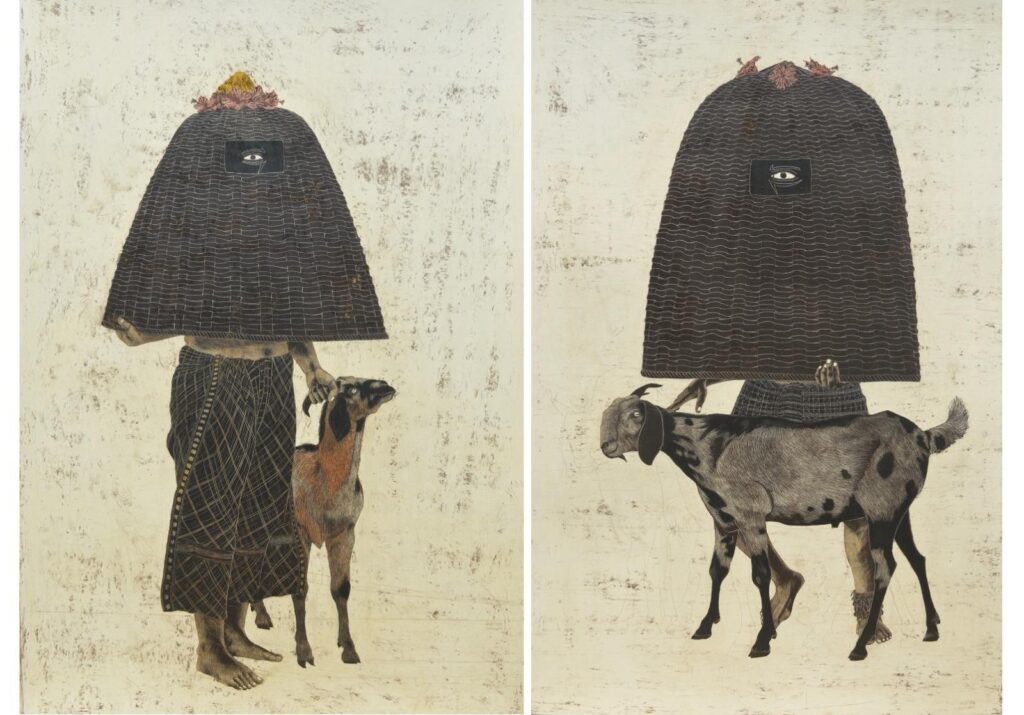
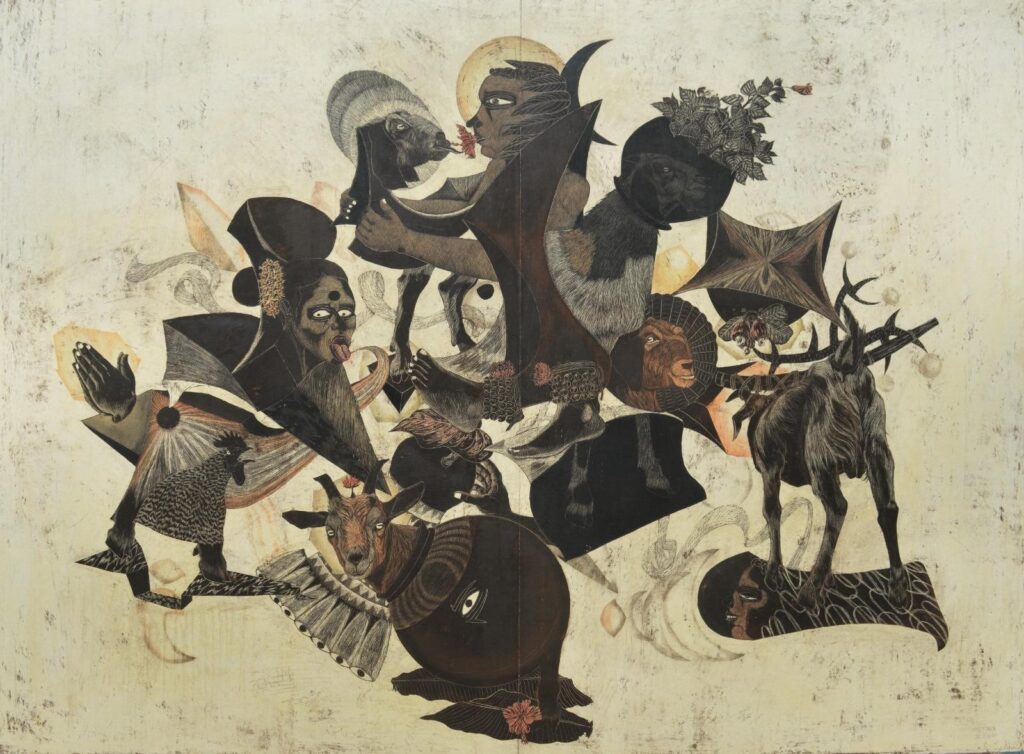
.
In this composition, Kuttum has balanced each and every element that represents a part of his community and his visits to his paternal village during childhood. The limited use of colours is brought forth through a process that was born out of necessity. When Kuttum shifted to Delhi to pursue his degree in fine arts from Delhi College of Art, he looked at the pictorial compositions by celebrated Indian artists like Atul Dodiya, Arpita Singh and Mithu Sen, each of these artists used art as an extension of their being – producing an incisive social commentary on the idea of a world inhabited by humans and their interaction with the material and metaphysical world. In a similar fashion, Kuttum’s art focuses on human condition and its connection with the natural world.
On a closer observation, we come across the finely detailed background in Kuttum’s paintings as he presents an imagery of nature, the lands, mountains, and topographical details of the same. He has spoken about the current land mining in the Andamans, which is specifically done to procure marble from the island, thus bringing attention to the rapid urbanisation of the once untouched lands, investigating the paradox of development. His journey which began from the exploration of human connection with nature and their rituals as a product of that interaction, has forayed into a more philosophical territory of land and its ownership. The encroachment that is born out of human greed for control over land which has disturbed the natural order of things. In a poetic manner, Kuttum has compared the man-made monuments with the marvels of nature – mountains. He speaks about the omnipresence and divine nature of mountains which seem to control everything around them ranging from human settlements to the type of vegetation that grows around, functioning as an epicentre, similarly monuments symbolise the might of human prowess and evolution of technology, signifying the dogged determination of human soul. Thus, his visual representations are now governed by more geometric forms that capture the urbanscapes which are Kuttum’s new abode.
.
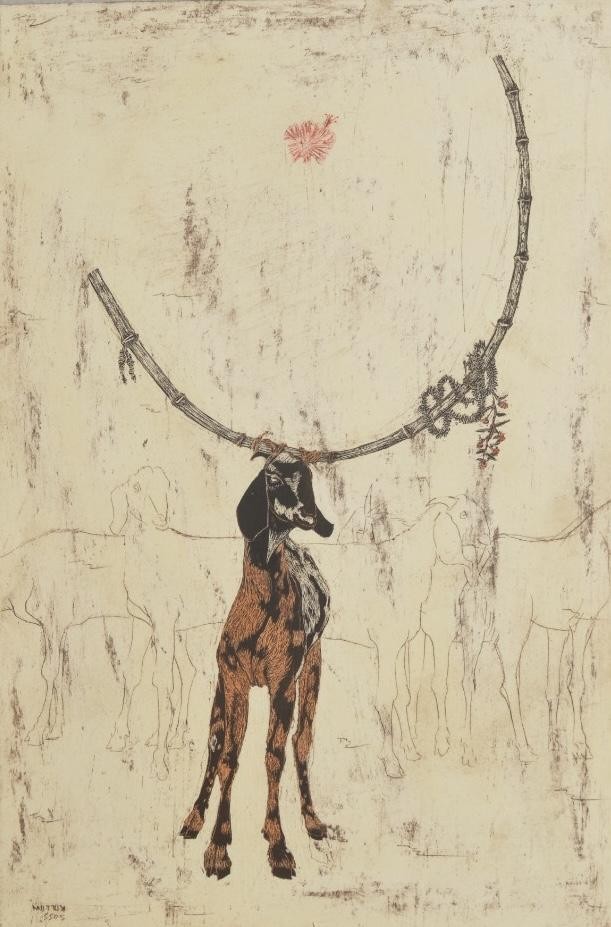
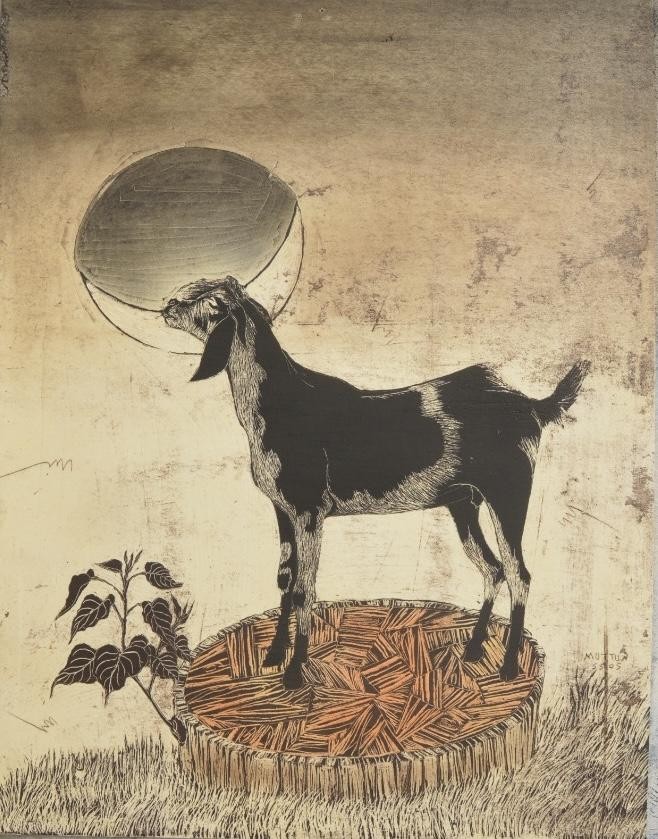
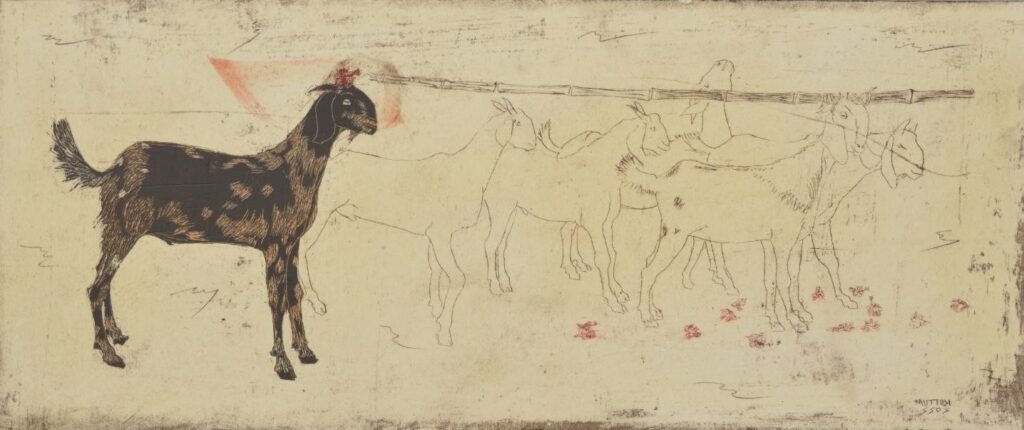
.
Embedding his works with themes of social responsibility and careful delineation of mythic stories and rituals, Kuttum’s narratives delineate the entropic relationship between the practical and spiritual worlds that govern mankind. On one hand, his nostalgic anecdotes underpin the ritualistic celebrations of his community, while his evolving practice is focusing upon the value of land in a grander scheme of things; forcing us to look at natural resources as an extension of sacred ideas and metaphysical postulations which instills a sense of responsibility towards environmental issues. At a first glance, his works might seem to be a part of a larger surrealistic narrative, but they function as social commentary on the issues of endangered land and natural resources that are direct results of human greed and ignorance. Kuttum’s works function as poems that celebrate yore while warning us about its ephemeral nature; as we forget about our connection with land and its offerings.
About the artist:
Viswanath Kuttum studied painting at the Government Institute of Fine Art, Gwalior, followed by Masters in painting from the College of Art, New Delhi.
Viswanath’s work is inspired by the simple life and customs of the Andamans. While the subject in his works is often borrowed from the tribal cultures, the style and technique he employs are contemporary. His medium is developed himself – with paraffin and beeswax, double boiled linseed oil, resin, zinc white and natural powders.
Viswanath has been awarded the prestigious Elizabeth Greenshields Foundation grant in 2020, and has received the Khoj Support Grant-2020.
In his recent works, Kuttum interprets the silent moments between the ‘characters’ in his frame. He is interested in the in-betweenness and the transitional, one that is neither in the present nor in an imagined space. There are metaphors at play when he makes broken objects, like a tattered basket. Commonly used and an integral part symbolises the imperfection of life itself. Kuttum’s occasional painting involves a busy cluster of juxtaposed elements, quite contrary to the usual singular bold element. He has also experimented with an uneven silhouette of the canvas itself. These have a direct motivation from his own state of mind. A restless and emotionally heightened psyche has a direct impact on his format of image making.
